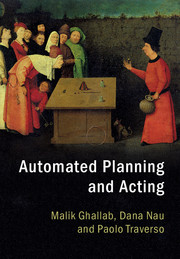Book contents
- Frontmatter
- Dedication
- Contents
- List of Algorithms
- Table of Notation
- Foreword
- Preface
- 1 Introduction
- 2 Deliberation with Deterministic Models
- 3 Deliberation with Refinement Methods
- 4 Deliberation with Temporal Models
- 5 Deliberation with Nondeterministic Models
- 6 Deliberation with Probabilistic Models
- 7 Other Deliberation Functions
- 8 Concluding Remarks
- Appendix A Search Algorithms
- Appendix B Strongly Connected Components of a Graph
- Bibliography
- Index
Foreword
Published online by Cambridge University Press: 05 August 2016
- Frontmatter
- Dedication
- Contents
- List of Algorithms
- Table of Notation
- Foreword
- Preface
- 1 Introduction
- 2 Deliberation with Deterministic Models
- 3 Deliberation with Refinement Methods
- 4 Deliberation with Temporal Models
- 5 Deliberation with Nondeterministic Models
- 6 Deliberation with Probabilistic Models
- 7 Other Deliberation Functions
- 8 Concluding Remarks
- Appendix A Search Algorithms
- Appendix B Strongly Connected Components of a Graph
- Bibliography
- Index
Summary
Over ten years ago, Malik Ghallab, Dana Nau, and Paolo Traverso gave us the first – and to date only – comprehensive textbook dedicated to the field of Automated Planning, providing a much needed resource for students, researchers and practitioners. Since then, this rich field has continued to evolve rapidly. There is now a unified understanding of what once seemed disparate work on classical planning. Models and methods to deal with time, resources, continuous change, multiple agents, and uncertainty have substantially matured. Cross-fertilization with other fields such as software verification, optimization, machine learning, and robotics has become the rule rather than the exception. A phenomenal range of applications could soon be within reach – given the right future emphasis for the field.
Today, the authors are back with a new book, Automated Planning and Acting. As the title indicates, this is not a mere second edition of the older book. In line with the authors’ analysis of where the future emphasis should lie for the field to realize its full impact, the book covers deliberative computational techniques for both planning and acting, that is, for deciding which actions to perform and also how to perform them. Automated Planning and Acting is more than a graduate textbook or a reference book. Not only do the authors outstandingly discharge their duties of educating the reader about the basics and much of the recent progress in the field, but they also propose a new framework from which the community can start to intensify research on deliberative acting and its integration with planning.
These aims are reflected in the book's content. The authors put the integration of planning and acting at the forefront by dedicating an entire chapter to a unified hierarchical model and refinement procedures that suit the needs of both planning and acting functions. Each chapter devoted to a particular class of representations also includes significant material on the integration of planning and acting using these representations. Overall, the book is more focused than its predecessor, and explores in even greater depth models and approaches motivated by the needs of planning and acting in the real world, such as handling time and uncertainty. At the same time, the authors successfully balance breadth and depth by providing an elegant, concise synthesis of a larger body of work than in their earlier text.
- Type
- Chapter
- Information
- Automated Planning and Acting , pp. xiii - xivPublisher: Cambridge University PressPrint publication year: 2016

